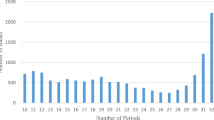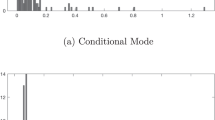Abstract
This paper proposes a stochastic frontier model with three composed errors, and therefore six error components. As in the metafrontier literature, firms belong to groups with a group-specific frontier. A firm has a level of short-run and long-run inefficiency relative to its group-specific frontier, as in existing models with two composed errors and four error components. But now there is also a group-specific inefficiency, that is, a shortfall of the group-specific frontier from the best practice metafrontier. The paper shows how to estimate this model and how to extract predictions of the various inefficiencies.
Similar content being viewed by others
References
Amsler C, O’Donnell CJ, Schmidt P. Stochastic metafrontiers. Econom Rev. 2017;36:1007–20.
Amsler C, Prokhorov A, Schmidt P. Using copulas to model time dependence in stochastic frontier models. Econom Rev. 2014;33:497–522.
Azzalini A. A class of distributions which includes the normal ones. Scand J Stat. 1985;12:171–8.
Battese GE, Rao DSP. Technology gap, efficiency, and a stochastic metafrontier function. Int J Bus Econ. 2002;1:87–93.
Battese GE, Rao DSP, O’Donnell CJ. A metafrontier production function for estimation of technical efficiencies and technology gaps for firms operating under different technologies. J Prod Anal. 2004;21:91–103.
Colombi R, Martini G, Vittadini G (2011) A stochastic frontier model with short-run and long-run inefficiency random effects. Working Paper, University of Bergamo.
Colombi R, Kumbhakar SC, Martini G, Vittadini G. Closed skew normality in stochastic frontiers with individual effects and long/short-run inefficiency. J Prod Anal. 2014;42:123–36.
Domínguez-Molina JA, González-Farías G, Ramos-Quiroga R (2003) Skew normality in stochastic frontier analysis. Commun Tech. I-03-18, 1–13.
Filippini M, Greene W. Persistent and transient productive inefficiency: a maximum simulated likelihood approach. J Prod Anal. 2016;45:187–96.
Fuller WA, Battese GE. Transformations for estimation of linear models with nested-error structure. J Am Stat Assoc. 1973;68:626–32.
González-Farías G, Domínguez-Molina JA, Gupta AK. Additive properties of skew normal random vectors. J Stat Plan Inference. 2004a;126:521–34.
González-Farías G, Domínguez-Molina JA, Gupta AK. The closed skew normal distribution. In: Genton M, editor. Skew elliptical distributions and their applications: a journey beyond normality. Boca Raton: Chapman and Hall; 2004b.
Hayami Y, Ruttan VW. Agricultural development: an international perspective. Baltimore: The Johns Hopkins University Press; 1971.
Hayami Y, Ruttan VW. Agricultural development: an international perspective. Revised and expanded ed. Baltimore: The Johns Hopkins University Press; 1985.
Kim J-S, Frees EW. Multilevel modelling with correlated effects. Psychometrika. 2007;72:505–33.
Kumbhakar SC, Lien G, Hardaker JB. Technical efficiency in competing panel data models. J Prod Anal. 2014;41:321–37.
Lai H-P, Kumbhakar SC. Panel data stochstic frontier model with determinants of persistent and transient inefficiency. Eur J Oper Res. 2018;271:746–55.
Lau LJ, Yotopoulos PA. The meta-production function approach to technological change in world agriculture. J Dev Econ. 1989;31:241–69.
Li Q, Racine J. Nonparametric econometrics: theory and practice. London: Princeton University Press; 2006.
Matyas L, editor. The econometrics of multi-dimensional panels. Berlin: Springer; 2017.
Moreira V, Bravo-Ureta B. Technical efficiency and metatechnology ratios for dairy farms in three southern cone countries: a stochastic meta-frontier model. J Prod Anal. 2010;33:33–45.
O’Donnell CJ, Rao DSP, Battese GE. Metafrontier frameworks for the study of firm-level efficiencies and technology ratios. Empir Econom. 2008;34:231–55.
Pitt MM. Farm-level fertilizer demand in Java: a meta-production function approach. Am J Agric Econ. 1983;65:502–8.
Raudenbush SW, Bryk AS. Hierarchical linear models: applications and data analysis methods. 2nd ed. London: Sage Publications; 2002.
Tsionas EG, Kumbhakar SC. Firm heterogeneity, persistent and transient technical inefficiency: a generalized true random effects model. J Appl Econom. 2014;29:110–32.
Villano R, Bravo-Ureta B, Solis D, Fleming E. Modern rice technologies and productivity in the Philippines: disentangling technology from managerial gaps. J Agric Econ. 2015;66:129–54.
Wooldridge JM. Econometric analysis of cross section and panel data. 2nd ed. Cambridge: MIT Press; 2010.
Yang Y, Schmidt P (2020) An econometric approach to the estimation of multi-level models. J Econom. (forthcoming).
Author information
Authors and Affiliations
Corresponding author
Ethics declarations
Conflict of interest
All of the authors declare that they have no conflicts of interest.
Ethical approval
This article does not contain any studies with human participants or animals performed by any of the authors.
Additional information
Publisher's Note
Springer Nature remains neutral with regard to jurisdictional claims in published maps and institutional affiliations.
Appendix
Appendix
We wish to derive an expression for the density of \( \varepsilon_{\left( g \right)} = \left( {\varepsilon_{11} , \ldots ,\varepsilon_{1T} , \ldots ,\varepsilon_{{n_{g} 1}} , \ldots ,\varepsilon_{{n_{g} T}} } \right)^{{\prime }} \). The starting point will be the density of \( \xi_{g} = \left( {c_{1} , \ldots ,c_{{n_{g} }} ,w_{g} ,u_{11} , \ldots ,u_{{n_{g} T}} } \right). \) Since we are dealing with a specific group, group g, we will simplify the notation, for this “Appendix” only, by omitting the subscript g. Thus we write \( \varepsilon \) in place of \( \varepsilon_{g} \), \( \xi \) in place of \( \xi_{g} \), \( w \) in place of \( w_{g} \) and n in place of \( n_{g} \). We will use results on the closed skew-normal distribution from González-Farías et al. (2004b) (hereafter GDG).
A p-dimensional random variable Z is distributed as \( {\text{CSN}}_{p,q} \left( {\mu ,\varSigma ,D,\nu ,\Delta } \right) \) if its density is \( f\left( z \right) = C\varphi_{p} \left( {z;\mu ,\varSigma } \right)\varPhi_{q} \left( {D\left( {z - \mu } \right);\nu ,\Delta } \right) \). Here \( \varphi_{p} \) and \( \varPhi_{q} \) are the p-variate normal density and the q-variate normal cdf, respectively, and \( C^{ - 1} = \varPhi_{q} \left( {0;\nu ,\Delta + D\varSigma D^{\prime}} \right) \). The dimensions of the parameters are as follows: \( \mu :p \times 1, \varSigma :p \times p, D:q \times p,\nu :q \times 1,\Delta :q \times q \). The relevance of this to the our model is that the composed error ci, with parameters \( \lambda_{c} \) and \( \sigma_{c}^{2} \), is distributed as \( {\text{CSN}}_{1,1} \left( {0,\sigma_{c}^{2} , - \frac{{\lambda_{c} }}{{\sigma_{c} }},0,1} \right) \), and similarly for w and \( u_{it} \).
Proposition 2.4.1 of GDG says that independent marginally CSN random variables are jointly CSN. Generically, if \( Z = \left( {Z_{1}^{{\prime }} , \ldots ,Z_{k}^{{\prime }} } \right)^{{\prime }} \) where the \( Z_{j} \) are mutually independent and \( Z_{j} \) ~ \( {\text{CSN}}_{{p_{j} ,q_{j} }} \left( {\mu_{j} ,\varSigma_{j} ,D_{j} ,\nu_{j} ,\Delta_{j} } \right) \), then Z ~ \( CSN_{p,q} \left( {\mu ,\varSigma ,D,\nu ,\Delta } \right) \), where \( p = \mathop \sum \limits_{j} p_{j} \), \( q = \mathop \sum \limits_{j} q_{j} \), \( \mu = \left( {\mu_{1} ', \ldots ,\mu_{k} '} \right)' \), \( \nu = \left( {\nu_{1}^{{\prime }} , \ldots ,\nu_{k}^{{\prime }} } \right)^{{\prime }} \), \( \varSigma = \oplus_{j = 1}^{k} \varSigma_{j} \), \( D = \oplus_{j = 1}^{k} D_{j} \), \( \Delta = \oplus_{j = 1}^{k} \Delta_{j} \). Here ⊕ is the matrix direct sum operator that makes matrices A and B into a block diagonal matrix: \( A \oplus B = \left[ {\begin{array}{*{20}c} A & O \\ O & B \\ \end{array} } \right] \). In our case, this implies that \( \xi \sim\,{\text{CSN}}_{q,q} \left( {\mu ,\varSigma ,D,\nu ,\Delta } \right) \) where \( q = n\left( {T + 1} \right) + 1 \) and:
Proposition 2.3.1 of GDG says that linear combinations of jointly CSN random variables are jointly CSN. Generically, suppose that Z ~ \( {\text{CSN}}_{p,q} \left( {\mu ,\varSigma ,D,\nu ,\Delta } \right) \) and let A be \( m \times p,m \le p, \) rank(A) = m. Then AZ ~ \( {\text{CSN}}_{m,q} \left( {\mu_{A} ,\varSigma_{A} ,D_{A} ,\nu ,\Delta_{A} } \right) \), where \( \mu_{A} = A\mu \), \( \varSigma_{A} = A\varSigma A' \), \( D_{A} = D\varSigma A'\varSigma_{A}^{ - 1} \), \( \Delta_{A} = \Delta + D\varSigma D^{{\prime }} - D\varSigma A^{{\prime }} \varSigma_{A}^{ - 1} A\varSigma D^{{\prime }} \). In our case, \( \varepsilon = A\xi \) where A is \( nT \times q \) and is defined as follows:
Therefore, \( \varepsilon \sim CSN_{nT,q} \left( {\mu_{A} ,\varSigma_{A} ,D_{A} ,\nu ,\Delta_{A} } \right) \) and the density of \( \varepsilon \) is
where \( C_{A}^{ - 1} = \varPhi_{q} \left( {0;\nu ,\Delta_{A} + D_{A} \varSigma_{A} D_{A}^{{\prime }} } \right). \)
Some of these arguments of the density can be simplified. For example, \( \mu_{A} = 0 \), \( \nu = 0 \), and \( \varSigma_{A} = \sigma_{u}^{2} I_{nT} + \sigma_{c}^{2} \left( {I_{n} \otimes 1_{T} 1_{T}^{'} } \right) + \sigma_{w}^{2} 1_{nT} 1_{nT} ' \). However, \( D_{A} \) and \( \Delta_{A} \) are rather complicated, and, importantly, \( \Delta_{A} \) does not have any special algebraic structure (e.g., block diagonal) that would allow the dimensionality of the integral implicit in the cdf \( \varPhi_{q} \left( {D_{A} \varepsilon ;0,\Delta_{A} } \right) \) to be reduced. So we are left with the task of evaluating the joint cdf of a multivariate normal of dimension \( q = n\left( {T + 1} \right) + 1 \). This is not likely to be practical.
Rights and permissions
About this article
Cite this article
Amsler, C., Chen, Y.Y., Schmidt, P. et al. A hierarchical panel data stochastic frontier model for the estimation of stochastic metafrontiers. Empir Econ 60, 353–363 (2021). https://doi.org/10.1007/s00181-020-01929-w
Received:
Accepted:
Published:
Issue Date:
DOI: https://doi.org/10.1007/s00181-020-01929-w




